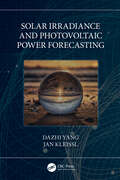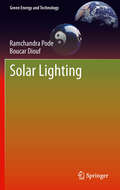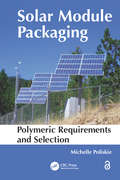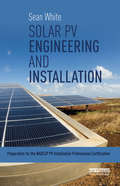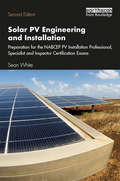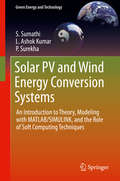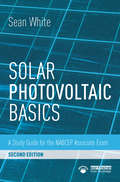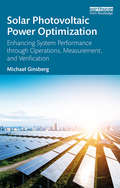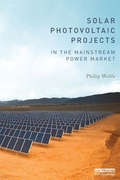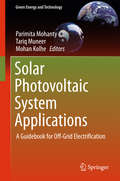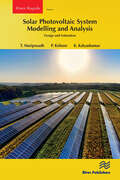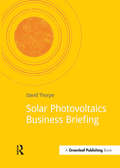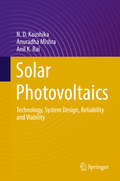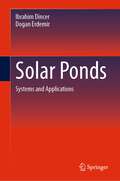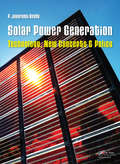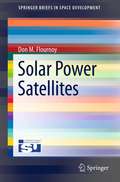- Table View
- List View
Solar Home Heating Basics
by Dan ChirasAs fossil fuel supplies dwindle, home heating will be one of the major challenges in temperate and cold climates in upcoming years. The reserves of natural gas used to heat the majority of North American buildings are rapidly being depleted. This latest Green Energy Guide helps readers who want to slash their energy bills and reduce their dependence on scarce resources to navigate the sometimes confusing maze of clean, reliable, and affordable options.Solar Home Heating Basics focuses on renewable energy strategies to heat new and existing homes and small businesses. These include:*Energy efficiency, weatherization, and insulation*Solar hot air heating*Solar thermal systems*Passive solar heating*Backup heating systemsWhile most solar home heating resources are geared primarily towards new buildings, this practical guide addresses ways of retrofitting existing buildings, making solar a reality for many people.Packed with all the essential information home and small business owners need to find alternatives to conventional heating solutions, Solar Home Heating Basics is your key to a personal energy solution.Dan Chiras is a respected educator and the author of thirty books on residential renewable energy and green building, including The Homeowner's Guide to Renewable Energy and Power from the Sun. Dan is the director and lead instructor at the Evergreen Institute's Center for Renewable Energy and Green Building, where he teaches workshops on energy efficiency, solar electricity, solar hot water, small wind energy, green building, natural plasters, and natural building.
Solar Hydrogen Energy Systems
by Paolo Tartarini Gabriele ZiniIt is just a matter of time when fossil fuels will become unavailable or uneconomical to retrieve. On top of that, their environmental impact is already too severe. Renewable energy sources can be considered as the most important substitute to fossil energy, since they are inexhaustible and have a very low, if none, impact on the environment. Still, their unevenness and unpredictability are drawbacks that must be dealt with in order to guarantee a reliable and steady energy supply to the final user. Hydrogen can be the answer to these problems. This book presents the readers with the modeling, functioning and implementation of solar hydrogen energy systems, which efficiently combine different technologies to convert, store and use renewable energy. Sources like solar photovoltaic or wind, technologies like electrolysis, fuel cells, traditional and advanced hydrogen storage are discussed and evaluated together with system management and output performance. Examples are also given to show how these systems are capable of providing energy independence from fossil fuels in real life settings.
Solar Irradiance and Photovoltaic Power Forecasting (Energy Analytics)
by Dazhi Yang Jan KleisslForecasting plays an indispensable role in grid integration of solar energy, which is an important pathway toward the grand goal of achieving planetary carbon neutrality. This rather specialized field of solar forecasting constitutes both irradiance and photovoltaic power forecasting. Its dependence on atmospheric sciences and implications for power system operations and planning make the multi-disciplinary nature of solar forecasting immediately obvious. Advances in solar forecasting represent a quiet revolution, as the landscape of solar forecasting research and practice has dramatically advanced as compared to just a decade ago. Solar Irradiance and Photovoltaic Power Forecasting provides the reader with a holistic view of all major aspects of solar forecasting: the philosophy, statistical preliminaries, data and software, base forecasting methods, post-processing techniques, forecast verification tools, irradiance-to-power conversion sequences, and the hierarchical and firm forecasting framework. The book’s scope and subject matter are designed to help anyone entering the field or wishing to stay current in understanding solar forecasting theory and applications. The text provides concrete and honest advice, methodological details and algorithms, and broader perspectives for solar forecasting. Both authors are internationally recognized experts in the field, with notable accomplishments in both academia and industry. Each author has many years of experience serving as editors of top journals in solar energy meteorology. The authors, as forecasters, are concerned not merely with delivering the technical specifics through this book, but more so with the hopes of steering future solar forecasting research in a direction that can truly expand the boundary of forecasting science.
Solar Light-to-Hydrogenated Organic Conversion: Heterogeneous Photocatalysts
by Hairus AbdullahThis book highlights the promising photocatalytic methods for synthesizing organic chemicals by simultaneously degrading the toxicity of raw substances used for organic synthesis. It presents various semiconducting materials with high catalytic activities in hydrogen evolution reactions (HERs) and hydrogenation reactions, as well as the material characterizations for identifying semiconductor photocatalysts. The focus is on understanding the hydrogen dissociation and activation of substances in the process of hydrogenation and the fabrication of nanostructured catalysts with desired activity and selectivity. Recent works show photocatalytic hydrogenation reactions with in situ generated H+ on catalyst surfaces utilizing initial chemicals such as nitrophenol, nitrobenzene, azobenzene, and benzene for valorization. In addition, the photocatalytic valorization of waste glycerol is also discussed. Besides the hydrogenation reactions, the reduction of oxygen to form H2O2 can be done with a photocatalytic method in atmospheric conditions. Some related perspectives and outlooks are also discussed for possible future development.
Solar Lighting
by Ramchandra Pode Boucar DioufLimited availability of grid-based electricity is a major challenge faced by many developing countries, particularly the rural population. Fuel-based lighting, such as the kerosene lantern, is widespread in these areas, but it is a poor alternative, contributing to global warming and causing serious health problems. Several developing countries are therefore now encouraging the use of sustainable lighting. Solar Lighting gives an in-depth analysis of energy-efficient light production through the use of solar-powered LED systems. The authors pay particular attention to the interplay between energy transformation and device efficiency. They also discuss diverse aspects of renewable energy, including how an improvement in the efficiency of appliances can reduce the cost of energy. Solar Lighting is written for physicists, environmental experts and lighting engineers. It is also suitable for undergraduate students in the fields of environmental science, electrical engineering and renewable energy.
Solar Module Packaging: Polymeric Requirements and Selection
by Michelle PoliskieExploring current and future opportunities in PV polymeric packaging, this work offers an insider's perspective on the manufacturing processes and needs of the solar industry and reveals opportunities for future material development and processing. Suitable for nonspecialists in polymer science, it provides a basic understanding of polymeric concepts, fundamental properties, and processing techniques commonly used in solar module packaging. The book also presents guidelines for using polymers in commercial PV modules as well as the tests required to establish confidence in the selection process.
Solar PV Engineering and Installation: Preparation for the NABCEP PV Installation Professional Certification
by Sean WhiteThe NABCEP PV Installation Professional Exam is the gold standard certification exam for PV professionals and is famously difficult to pass. This book will provide test-taking strategy that can be used to most effectively study for and pass the exam. Code and theory is explained in the first half and will prove as useful background for the heart of the book which consists of practice exam questions and detailed explanations of the answers. It also contains essential strategy tools, short term memory tips and recommended reading which will be invaluable for anyone studying for the exam. The material in this book is not limited to those taking the exam as it will also be, more broadly, important for career progression and helping the reader to work safely with code compliant PV systems.
Solar PV Engineering and Installation: Preparation for the NABCEP PV Installation Professional, Specialist and Inspector Certification Exams
by Sean WhiteThe NABCEP PV Installation Professional (PVIP) Exam is the gold standard certification exam for PV professionals and is famously difficult to pass. As the industry grows and jobs have become more specialized, the Board has responded to this with NABCEP Specialist Certification Exams. As well as the content of the PVIP, this book also covers the material in the Design, Installer and Commissioning & Maintenance Specialist Certification Exams, and provides test-taking strategy that can be used to most effectively study for and pass these assessments. Code and theory is explained in the first half of this guide, acting as a useful background for the second half, which consists of practice exam questions and answers, complete with detailed explanations. It also contains essential strategy tools, short-term memory tips and recommended reading which will be invaluable for anyone studying for the exams. The material covered in this book is not limited to those taking the test, but will also act as a valuable tool for career progression, helping the reader to work safely with code-compliant PV systems. This second edition has been fully revised and updated to reflect the new developments in solar and energy storage systems and new technologies.
Solar PV and Wind Energy Conversion Systems
by S. Sumathi L. Ashok Kumar P. SurekhaThis textbook starts with a review of the principles of operation, modeling and control of common solar energy and wind-power generation systems before moving on to discuss grid compatibility, power quality issues and hybrid models of Solar PV and Wind Energy Conversion Systems (WECS). MATLAB/SIMULINK models of fuel cell technology and associated converters are discussed in detail. The impact of soft computing techniques such as neural networks, fuzzy logic and genetic algorithms in the context of solar and wind energy is explained with practical implementation using MATLAB/SIMULINK models. This book is intended for final year undergraduate, post-graduate and research students interested in understanding the modeling and control of Solar PV and Wind Energy Conversion Systems based on MATLAB/SIMULINK. - Each chapter includes "Learning Objectives" at the start, a "Summary" at the end and helpful Review Questions - Includes MATLAB/SIMULINK models of different control strategies for power conditioning units in the context of Solar PV - Presents soft computing techniques for Solar PV and WECS, as well as MATLAB/SIMULINK models, e. g. for wind turbine topologies and grid integration - Covers hybrid solar PV and Wind Energy Conversion Systems with converters and MATLAB/SIMULINK models - Reviews harmonic reduction in Solar PV and Wind Energy Conversion Systems in connection with power quality issues - Covers fuel cells and converters with implementation using MATLAB/SIMULINK
Solar Photocatalysis for Environmental Remediation
by Sampa ChakrabartiThe book presents a review of research and pilot-scale efforts undertaken by scientists all over the world towards utilization of solar energy for environmental remediation. It gives a complete account of the solar photocatalytic degradation of pollutants present in wastewater and atmosphere and also discusses the solid-phase photocatalytic degradation of plastics in the form of composite. The text further describes the hydrogen generation by photocatalytic water splitting. Various solar collectors and reactors used especially for environmental remediation are also elucidated. Please note: This volume is Co-published with The Energy and Resources Institute Press, New Delhi. Taylor & Francis does not sell or distribute the Hardback in India, Pakistan, Nepal, Bhutan, Bangladesh and Sri Lanka
Solar Photovoltaic Basics: A Study Guide for the NABCEP Associate Exam
by Sean WhiteThis book explains the science of photovoltaics (PV) in a way that most people can understand, using the curriculum which reflects the core modules of the NABCEP Associate Exam. Whether or not you are taking the NABCEP Associate Exam, learning the material covered in this book is the best investment you can make insuring your place and moving up in the solar industry. Providing complete coverage of the NABCEP syllabus in easily accessible chapters, this book addresses all of the core objectives required to pass the exam, including the ten main skill sets: PV Markets and Applications Safety Basics Electricity Basics Solar Energy Fundamentals PV Module Fundamentals System Components PV System Sizing Principles PV System Electrical Design PV System Mechanical Design Performance Analysis, Maintenance and Troubleshooting. You will learn the importance of surveying a site and how to carry out a survey, how to use the tools that determine shading and annual production, and the necessity of safety on site. This guide also includes technical math and equations that are suitable and understandable to those without engineering degrees, but are necessary in understanding the principles of solar PV. This new edition of Sean White’s highly successful study guide has been updated throughout and reflects recent changes in the industry.
Solar Photovoltaic Power Optimization: Enhancing System Performance through Operations, Measurement, and Verification
by Michael GinsbergThis book focuses on the rapidly maturing solar photovoltaic (PV) industry, which is achieving an ever-increasing share of U.S. and global power production. There is a growing need for all stakeholders – owners, maintenance technicians, utilities, and installers – to fully understand the operations and maintenance of PV systems, and how to monitor and diagnose systems post installation. Recognizing this need, this book covers monitoring and diagnostic techniques and technologies, including how to identify the causes of poor performance, and measure and verify power production. Drawing on global case studies, it details how to achieve optimal PV power output in the field through an overview of basic electrical, the solar PV module and Balance of System, and processes and software for monitoring, measurement, and verification. It also provides an overview of the North American Board of Certified Energy Practitioner’s (NABCEP) new PV System Inspector credential, which will be outlined in the final chapter. Equipping the reader with the knowledge and confidence required to maximize the output of solar PV installations, Solar Photovoltaics Power Optimization will be an essential resource for PV practitioners and students.
Solar Photovoltaic Projects in the Mainstream Power Market
by Philip WolfeThis is the first and probably the only book devoted to utility-scale solar power – perhaps the fastest-growing sector of the global energy market. Philip Wolfe’s book describes the development and operation of large-scale solar power stations, and will interest all those who want to understand how these multi-million dollar projects are designed, structured, financed, constructed and maintained. It contains case studies of the Waldpolenz Energy Park, Germany, Lopburi Solar Plant in Thailand and the Topaz Solar Farm in California. Also included are interviews from leading figures in the PV industry. It shows the state of the world market and links to an online resource that continues to track the explosive growth of the sector. The book is arranged in three sections: A description of solar projects in context, and how they are undertaken. Chapters on developing and structuring projects; siting, consenting and connection issues; building and operating solar plants; design and technology basics; economies of solar photovoltaics. The second section reviews individual aspects of the project development and operational process in more detail. In particular it advises on strategies to manage technology, commercial, regulatory and implementation risks. These are supported by a comprehensive reference section, including case studies and overviews of key parameters applicable in different parts of the world. Supported by figures and photographs, this book is for anyone wanting to master the commercial, professional, financial, engineering or political aspects of developing multi-mega-watt solar PV projects in a mainstream power market. It is a ‘user manual’ to accompany a sector which by 2015 had surpassed a value of $100 billion.
Solar Photovoltaic System Applications
by Parimita Mohanty Tariq Muneer Mohan KolhePresenting a complete guide for the planning, design and implementation of solar PV systems for off-grid applications, this book features analysis based on the authors' own laboratory testing as well as their in the field experiences. Incorporating the latest developments in smart-digital and control technologies into the design criteria of the PV system, this book will also focus on how to integrate newer smart design approaches and techniques for improving the efficiency, reliability and flexibility of the entire system. The design and implementation of India's first-of its-kind Smart Mini-Grid system (SMG) at TERI premises, which involves the integration of multiple renewable energy resources (including solar PV) through smart controllers for managing the load intelligently and effectively is presented as a key case study. Maximizing reader insights into the performance of different components of solar PV systems under different operating conditions, the book will be of interest to graduate students, researchers, PV designers, planners, and practitioners working in the area of solar PV design, implementation and assessment.
Solar Photovoltaic System Modelling and Analysis: Design and Estimation (River Publishers Series in Power)
by T. Mariprasath P. Kishore K. KalyankumarThis book outlines the global opportunity to increase solar photovoltaic (PV) plant energy yields through modelling and analysis. Because it is endlessly available in Earth’s atmosphere, solar PV energy extraction is rising faster than all other renewable energy sources worldwide. Thus, technological improvements are needed to lower the cost of solar PV per watt every year. Since solar PV efficiency is low, modelling and analysis of boost converters, maximum power point tracing, solar PV cleaners, irradiation tracing systems, and panel tilt adjustments all help increase solar PV plant energy yield.Solar Photovoltaic System Modelling and Analysis covers topics such as: Relevance, types, and growth rate of renewable resources How solar PV systems generate electricity Panel varieties and their importance Solar PV designs and architectures Charge controllers, including the latest technologies Boost converter modelling and analysis in MATLAB The necessity of hybrid power plants (modelling and analysis) Designing a solar PV system including panel selection for a specific application, as well as converter and inverter estimation
Solar Photovoltaic Systems Installer Trainee Guide
by NccerThis exceptionally produced trainee guide features technical hints and tips from industry experts, review questions and a whole lot more!
Solar Photovoltaic Systems Installer Trainee Guide
by NccerThis exceptionally produced trainee guide features a highly illustrated design, technical hints and tips from industry experts, review questions and a whole lot more! Key content includes: Introduction to Solar Photovoltaics, Site Assessment, System Design, System Installation and Inspection, and Maintenance and Troubleshooting.
Solar Photovoltaics Business Briefing (Doshorts Ser.)
by David ThorpeThis book explains, for a UK business audience, the technical, scientific and economic aspects of solar photovoltaics (PV) technologies. It is useful to anyone considering a business use of solar PV, whether an investor, potential purchaser, or thinking of setting up a company in the sector.It succinctly examines: their applications and how to assess them; the prospects and drivers for cost reductions and implementation; the role of PV in carbon offsetting; and the business case for and against investment.It will arm the reader with sufficient knowledge to talk to contractors or to compile a business investment case for senior management.PV is the sunrise sector for electricity generation; the renewable technology whose time has come. Clean, and with no moving parts to wear out, it interfaces neatly with other technologies, both digital and analogue. Cost curves are decreasing and installation curves exponentially rising. Although silicon-based cells are well-known, due to the feed-in tariff support they receive, within the next five to eight years, lowering production costs and technological innovations will mean that solar electricity will be poised to find even more widespread applications.
Solar Photovoltaics: Technology, System Design, Reliability And Viability
by N. D. Kaushika Anuradha Mishra Anil K. RaiThis book presents a quantitative description of the physics of solar-cell materials, transport processes, fabrication methods, and offers a scientific understanding of the technology involved. It also presents the current knowledge of the electrical characteristics of modules arrays and balance of systems (BOS) for a wide spectrum of applications. It particularly focuses on solar-powered communication systems and building integrated photovoltaic (BIPV) systems, exploring the reliability and viability aspects in detail. The book is of interest to application engineers, practitioners in private and government agencies, as well as graduate and postgraduate students.
Solar Ponds: Systems and Applications
by Ibrahim Dincer Dogan ErdemirThis book is about solar ponds for energy storage from various perspectives, including fundamentals, efficiencies, system designs, local applications and details about what have been done in the world in the field of solar ponds for generating energy and storage it for useful purposes.
Solar Power (World About Us)
by Sarah LeveteDescribes Solar Energy, what it is, how we can use it to help protect our planet. for younger readers
Solar Power Generation Problems, Solutions, and Monitoring
by Peter GevorkianSolar Power Generation Problems, Solutions and Monitoring is a valuable resource for researchers, professionals and graduate students interested in solar power system design. Written to serve as a pragmatic resource for solar photovoltaic power systems financing, it outlines real-life, straightforward design methodology. Using numerous examples, illustrations and an easy to follow design methodology, Dr Peter Gevorkian discusses some of the most significant issues that concern solar power generation including: power output; energy monitoring and energy output enhancement; fault detection; fire and life safety hazard mitigation; and detailed hardware, firmware and software analytic solutions required to resolve solar power technology shortcomings. This essential reference also highlights the significant issues associated with large scale solar photovoltaic and solar power generation technology covering design, construction, deployment and fault detection monitoring as well as life safety hazards.
Solar Power Generation: Technology, New Concepts & Policy
by P. Jayarama ReddyThis book offers a global perspective of the current state of affairs in the field of solar power engineering. In four parts, this well-researched volume informs about:Established solar PV (photovoltaic) technologiesThird-generation PV technologies based on new materials with potential for low-cost large-scale productionSolar cell technology based
Solar Power Satellites
by Don M. FlournoyCommunication satellites are a $144 billion industry. Is there any space-based industry that could possibly beat that market? 'Solar Power Satellites' shows why and how the space satellite industry will soon begin expanding its market from relaying signals to Earth to generating energy in space and delivering it to the ground as electricity. In all industrialized nations, energy demand is growing exponentially. In the developing world, the need for energy is as basic as food and water. The Sun's energy is available everywhere, and it is non-polluting. As business plans demonstrate its technical feasibility, commercial potential, and environmental acceptability, every country on Earth will look to space for the power it needs.
Solar Power Your Home For Dummies
by Rik DeguntherThe bestselling alternative energy reference book in North America--now in an updated editionWant to take advantage of solar power in your home? Whether you're looking to save on your energy costs by adding a few solar components or you want to build a solar-powered house from the ground up, Solar Power For Dummies, 2nd Edition takes the mystery out of this energy source and shows you how to put it to work for you!This new edition gives you hands-on tips and techniques for making your home more energy-efficient though solar power--and helping the planet at the same time. Plus, you'll get all the latest information on changes to federal, state, and local regulations, laws, and tax incentives that seek to make solar-power adoption more feasible.Expanded coverage of the technology that underpins full-scale solar-power systems for the homeNew small- and mid-sized solar products, projects, and applicationsRik DeGunther is a design engineer who started his own energy consulting firmFeaturing ten of the easiest and cheapest DIY solar projects, Solar Power For Dummies, 2nd Edition is the fun and easy way to meet your energy needs with this clean power source!


